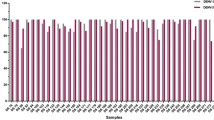Abstract
Chikungunya (CHIKV) reemerged in India after a gap of 32 years, in 2005–2006 and has established endemicity in Pune. To assess the degree of CHIKV exposure, we estimated age-stratified prevalence of IgG antibodies to CHIKV in Pune population. This retrospective study utilized age-stratified serum samples collected from 15 wards of Pune in 2017 for dengue (DENV) virus study. Indirect anti-CHIKV-IgG ELISA was developed and used to test 1904 samples. Exposure to CHIKV and DENV was compared in the same population. CHIKV-specific plaque reduction neutralization test (PRNT) was employed to evaluate ELISA positivity and neutralizing potential of anti-CHIKV-IgG antibodies. Indirect ELISA showed 98.5% concordance with commercial ELISA. Seropositivity to CHIKV was 46.4%, one-third children < 15 years being antibody positive. A significant increase (45%, p = 0.026–0.038) was noted at 16-25 years and varied between 48 and 56% until the age 65. In elderly (65 + years), antibody positivity was reduced (41%, p = 0.01). In children, CHIKV-PRNT50 titers increased with age and remained comparable from the age group 11-15 until > 65. Exposure to DENV was higher than CHIKV. Lower exposure of children and elderly could be due to lesser exposure to the vectors. High prevalence of IgG antibodies needs to be addressed while planning vaccine studies for CHIKV.





Similar content being viewed by others
References
Shah K, Gilotra S, Gibbs C, Rozeboon L (1964) Laboratory studies of transmission of chikungunya virus by mosquitoes-a preliminary report. Indian J Med Res 52:703–709
Arankalle VA, Shrivastava S, Cherian S, Gunjikar RS, Walimbe AM, Jadhav SM et al (2007) Genetic divergence of Chikungunya viruses in India (1963-2006) with special reference to the 2005-2006 explosive epidemic. J Gen Virol 88:1967–1976
Yergolkar PN, Tandale BV, Arankalle VA, Sathe PS, Sudeep AB, Gandhe SS et al (2006) Chikungunya outbreaks caused by African genotype, India. Emerg Infect Dis 12:10–13
Raghavendhar BS, Ray P, Ratagiri VH, Sharma BS, Kabra SKLR (2016) Evaluation of chikungunya virus infection in children from India during 2009-2010: a cross sectional observational study. J Med Virol 88:923–930
Ray P, Ratagiri VH, Kabra SK, Lodha R, Sharma S, Sharma BS et al (2012) Chikungunya infection in India: results of a prospective hospital based multi-centric study. PLoS One 7:1–8
Dinkar A, Singh J, Prakash P, Das A, Nath G (2018) Hidden burden of chikungunya in North India; A prospective study in a tertiary care centre. J Infect Public Health 11:586–591
Murhekar M, Kanagasabai K, Shete V, Joshua V, Ravi M, Kirubakaran BK et al (2019) Epidemiology of chikungunya based on laboratory surveillance data - India, 2016-2018. Trans R Soc Trop Med Hyg 00:1–4
Mishra AC, Arankalle VA, Gadhave S, Mahadik P, Shrivastava S, Bhutkar M et al (2018) Stratified sero-prevalence revealed overall high disease burden of dengue but suboptimal immunity in younger age groups in Pune, India. PLoS Negl Trop Dis 12:e0006657
Kulkarni R, Tiraki D, Wani D, Mishra AC, Arankalle VA (2018) Risk of transfusion-associated dengue: screening of blood donors from Pune, Western India. Transfusion 59(2):458–462
Aubry M, Teissier A, Huart M, Merceron S, Vanhomwegen J, Mapotoeke M et al (2018) Seroprevalence of dengue and chikungunya virus antibodies, French Polynesia, 2014–2015. Emerg Infect Dis 24:558–561
Kuan G, Ramirez S, Gresh L, Ojeda S, Melendez M, Sanchez N et al (2016) Seroprevalence of anti-chikungunya virus antibodies in children and adults in Managua, Nicaragua, after the first chikungunya epidemic, 2014-2015. PLoS Negl Trop Dis 10:2014–2015
Yoon IK, Alera MT, Lago CB, Tac-An IA, Villa D, Fernandez S et al (2015) High rate of subclinical chikungunya virus infection and association of neutralizing antibody with protection in a prospective cohort in the Philippines. PLoS Negl Trop Dis 9:1–14
Rodríguez-Barraquer I, Solomon SS, Kuganantham P, Srikrishnan AK, Vasudevan CK, Qbal SH et al (2015) The hidden burden of dengue and chikungunya in Chennai, India. PLoS Negl Trop Dis 9:1–15
Acknowledgments
We are grateful for the valuable support from the health officials of the Pune Municipal Corporation and the University authorities to make the study feasible. Samples from the study “Establishment of a novel Electronic Surveillance System for DENV in Pune: an initiative for Smart Cities Mission” funded by Indian Council of Medical Research, Government of India, New Delhi were used in this study. We also thank Mr. Rahul Patil for the statistical analysis.
Funding
The research was funded by the Interactive Research School for Health Affairs, Bharati Vidyapeeth (Deemed to be University), Pune.
Author information
Authors and Affiliations
Corresponding author
Additional information
Publisher’s note
Springer Nature remains neutral with regard to jurisdictional claims in published maps and institutional affiliations.
Rights and permissions
About this article
Cite this article
Patil, H.P., Rane, P.S., Gosavi, M. et al. Standardization of ELISA for anti-chikungunya-IgG antibodies and age-stratified prevalence of anti-chikungunya-IgG antibodies in Pune, India. Eur J Clin Microbiol Infect Dis 39, 1925–1932 (2020). https://doi.org/10.1007/s10096-020-03933-5
Received:
Accepted:
Published:
Issue Date:
DOI: https://doi.org/10.1007/s10096-020-03933-5




